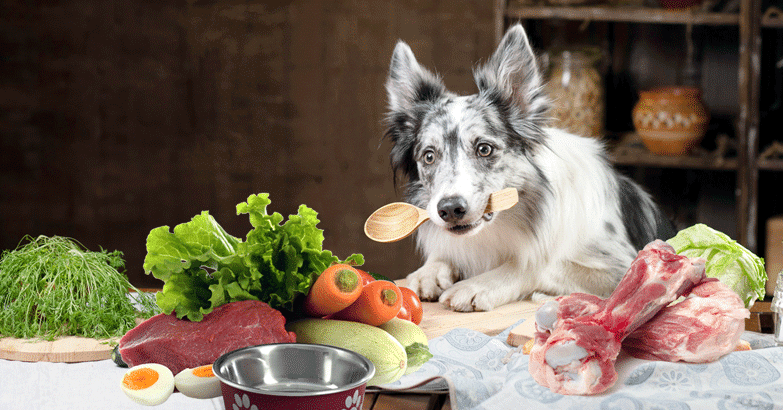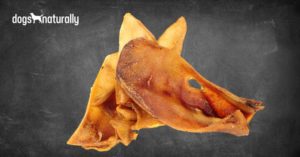There’s a long list of benefits to making homemade raw or cooked dog food. When you first make homemade dog food, it may seem a bit daunting … but it’s just a matter of getting into a routine, and in time it becomes second nature.
Making your own dog food gives you complete control over what your dog eats. You can choose the foods your dog likes and that offer nutritional value. As you find new sources and learn more, you can revise and change recipes to provide a variety of nutrients.
Here’s what you’ll learn below about making your own homemade dog food:
- Tools/equipment
- Breakdown of ingredients
- Calculating amounts
- Muscle meat
- Fish
- Eggs
- Organs and alternatives
- Bone
- Vegetables and fruit
- Fats
- How much to feed
- Recipes
Let’s start by looking at some pros and cons of homemade dog food.
Pros And Cons Of Homemade Dog Food
If you’re already feeding a pre-packaged raw diet, then you know the benefits of feeding raw, fresh whole foods. Now you can take it to the next level and make your own homemade dog food. Here are the positives when you make your own dog food:
- Control over ingredient quality
- Easy to modify for food sensitivities and dietary needs
- Best option for feeding fresh foods
- Often cheaper than pre-made
- Avoid synthetic additives
- Eliminate starchy grains and carbohydrates
- Source local ingredients
- Source better quality proteins
- Source organic and non-GMO produce
- Choose sustainable sources
Concerns about making your own dog food:
- More time-consuming
- The “ick” factor of handling raw meat and organs
- Ingredient sourcing can be challenging and time-consuming
- Concerns about balancing the diet
- Requires freezer space for storage
RELATED: Basic tips for getting started with raw dog food …
Tools You’ll Need
For raw food, you don’t need much more than a kitchen scale, som/e big mixing bowls, large spoons or paddle, a cutting board and a really sharp knife. You can always add a grinder or dehydrator later if you want to expand your dog food-making.
If you’re making cooked food, you’ll also need a large casserole or roasting pan, or you can use a crockpot.
For storage or molding, you can use silicone baking pans or muffin cups, food grade silicone containers, glass storage containers or plant-based eco-friendly storage bags. Pro tip: If using bags, fill them and press them down flat so they’re stackable in the freezer.
How To Make Homemade Dog Food
You can use recipes that have been pre-calculated, as you’ll find in the link below, or you can follow a few basic guidelines to make easy homemade dog food.
Muscle accounts for about 50% of most animals so that’s what you’ll include. Bone is about 12%. Most animals are about 22-25% organ meat by weight.
Breakdown Of Ingredients
Here’s what the basic formula looks like …
- 50% muscle meat (10-15% fat content)
- 25% organ meat
- 15% uncooked bone
- 10% vegetables and fruit
- Added essential fatty acids
Depending on the size of your dog or dogs, you can make as little or as much as needed so you can have a supply for a few days or more. If you have plenty of freezer space, you can make several recipes with different proteins to rotate for your dog’s meals.
RELATED: 5 easy to make homemade dog food recipes …
Dogs Don’t Need Starch
Many dog owners making homemade food, especially cooked foods, feel tempted to add grains, legumes or other starchy ingredients to the food.
Dogs don’t need any starchy carbohydrates. Foods that are high in carbohydrate can raise insulin and cause obesity. Some studies also show that dogs fed a high carbohydrate content have changes to their gut bacteria. Carbohydrates should come from non-starchy vegetables and fruit, not from grains, legumes or starchy vegetables like potatoes.
RELATED: Dog obesity: the truth about starch for dogs …
Calculating Amounts
Calculating percentages can be overwhelming and some people give up before they start. If you follow a balanced raw recipe or this cooked recipe, the math and ingredient lists have been done for you … and there’s a link to more recipes below).
If you don’t want to follow a recipe, here’s an easy DIY formula for homemade dog food for adult dogs. Let’s base it on 10 lbs, which gives you enough food to feed a 50 lb dog for 10 days. You’ll want:
- 5 lbs meat
- 2.5 lbs organs
- 1.5 lb bone
- 1 lb vegetables & fruit
If you’ve got a small dog you can do half the recipe … or just make the full amount and freeze it in meal-sized portions. You can also double or triple these figures to prep meals for larger dogs.
Add everything to a large bowl or a metal chafing dish so you can mix it well, portion it out and freeze. You can keep fresh homemade dog food in the fridge for 3 days.
RELATED: Here are more homemade dog food recipes …
Now let’s look at these components more closely …
Muscle Meat
Muscle meat should make up about 50% of your recipe … so, 5 lbs of a 10 lb recipe.
You want to ensure the muscle meat you use is lean – no more than 10% to 15% fat, The higher the fat content, the fewer nutrients your dog is getting from the meat or other ingredients in the food.
The most common animal proteins are chicken, turkey, pork and beef. Chicken is a popular protein for its affordability … but unless it’s pasture raised, chicken is high in omega-6 fatty acids, making it an inflammatory food … so you need to balance it with omega-3 fatty acids.
There’s nothing wrong with rotating between common proteins like beef, poultry and pork … but it’s great to include more variety with extra proteins like lamb, goat, rabbit, kangaroo, venison or other wild game and fish. The more variety you can add, the better range of nutrients you’ll be providing.
Some proteins are readily available but others will take some effort to source. Source these meats through butchers, farmer’s markets, raw dog food co-ops, Asian markets, specialty dog food suppliers or even hunters you might know.
Another reason to add variety is that feeding a single protein for long periods sometimes leads to food sensitivities.
Whenever possible and affordable, look for pastured, grass-fed and grass-finished animals. Research shows that grass-fed, pasture-raised meat, eggs and dairy products have higher nutrient levels, higher levels of anti-inflammatory omega-3 fatty acids, and better health benefits for your dog than grain-fed options.
But don’t be afraid to shop at supermarkets. Feeding any whole food diet to your dog is way better than feeding highly processed commercial foods. You may be able to save money in grocery stores by looking for stale-dated meats that are discounted and set aside. These are fine for your dog.
Fish
You can add an ounce of fish for every pound of dog food … so 10 oz in this 10 lb recipe.
Fish is a great addition that provides omega-3 fatty acids. Omega-3 fatty acids are anti-inflammatory, and are also essential in brain, eye, heart and immune health in people as well as pets. The best sources are cold-water fatty fish like salmon, mackerel, sardines, trout and herring. You can add cooked or raw fish. Canned fish in water is okay.
Try to find wild-caught fish as they have more nutrients than farmed fish … which are fed grains and often given antibiotics. In contrast, wild fish eat foods like kelp, algae, seaweed or smaller fish. Depending on the species, fish have vitamins A, D and B2 (riboflavin), and moderate to small amounts of iron, zinc, magnesium, copper and iodine.
Eggs
Most dogs can eat a raw or cooked egg every day or a few times a week.
Eggs are best if you can get them from a local organic farmer or farmers market. Then you can break an egg, shell and all, into your dog’s dinner bowl. Don’t feed the shell if you buy grocery store eggs, as they’re often washed or coated in chemicals. If you prefer to give cooked eggs, you can feed them soft or hard-boiled, or even scrambled in pastured butter.
Organ Meat
Organs and glands should make up about 25% of your homemade dog food … 2.5 lbs of a 10 lb recipe.
Organ meats are like a natural multivitamin, and much richer in minerals and trace minerals than muscle meat. Each organ has a different nutrient profile, so the more variety you add, the more nutrients you’ll have. Kidney, heart and liver are the easiest to obtain and offer a good range of nutrients. Other organs like brain, eyeballs, spleen, pancreas, lung and glands offer more nutrient variety … but are not as easy to find.
If you can find a dog food supplier who offers pre-mixed organ grinds you’ll save this entire next step, and some time.
If not, an abattoir is usually the best place to get a greater variety of organs. Many even have a retail area for pet owners. You’ll find a wider selection of organs like brain, eyeballs, spleen, pancreas, kidney, liver, heart, lung and glands. You can freeze them slightly to make them easier to slice or chop, or grind them raw.
Use as many different organs as possible. Mix up your chopped/ground organs and add 2.5 lbs to your meat and vegetable/fruit mix to total 10 lbs.
RELATED: Why most dog owners don’t feed enough organ meat …
Alternatives To Organs
If you can’t find organs, or a good assortment … use whole fish. Fish is rich in vitamin D and minerals and in DHA. Add an ounce of fish for every pound of raw food.
Another option is to use freeze-dried organ and glandular powders.
Bone Content
Bone in raw homemade dog food can vary between 10% and 25%, but should generally be about 12% to 15% of your food, so 1.2 to 1.5 lbs of a 10 lb recipe. Give 15% bone to puppies. You can grind bones and add them to food, or you can feed raw meaty bones (RMB) 2 or 3 times per week.
Here’s how to find bone content and calculate how to balance calcium …
This chart also shows you how to calculate the amount of bone to feed, once you know the percentage of bone in different cuts of meat from the link above.

Caution: Only include bones in your formula if you’re making raw food. Bones should never be cooked. You can use bone meal as a bone replacement in cooked food.
How Much Bone Meal To Feed
Feed adult dogs 2 tsp bone meal powder per pound of food. For puppies, give 4 teaspoons per pound of home-prepared food with 10% or less fat content, 5 tsp per lb for 11-15% fat content or 6 tsp per lb for 15-20% fat. You can also add bonemeal to raw food if you prefer not to feed raw bones to your dog.
Vegetables And Fruit
Fruits and vegetables should make up about 10%, or 1 lb of a 10 lb recipe.
Vegetables help balance out your dog’s diet and supply important phytonutrients that aren’t found in meat. Vegetables balance the alkalinity and acidity of your dog’s body which improves the function of organs like the liver, pancreas, gallbladder, hormones, heart and kidneys.
Vegetables are full of antioxidants that protect your dog from aging and disease. They’re also high in fiber and enzymes that help with the digestive process and support the microbiome of your dog’s gut. Phytonutrients help protect people and animals from cancers, heart disease, diabetes and more.
Including a variety of fruit provides polyphenols that are anti-inflammatory, prevent tumor formation, improve cognitive function and fight cancer, among other things.
Some nutritious produce to include are dark leafy greens, a wide range of colorful veggies to provide nutrient variety, low sugar fruits like berries, and microgreens.
Here are some of the best veggies for dogs …
Fats
Fats should be added when you feed your dog, rather than stirring it into the mix before cooking or freezing.
Fats should be 10% to 20% of your dog’s diet. The meat in your dog’s diet will be higher in omega-6 fatty acids, which can increase inflammation … so you’ll need to balance the fats by adding more omega-3 fats. We’ve provided some specific suggestions below on which types of fat to feed with different types of meat (ruminants like beef, lamb or goat vs poultry like chicken, turkey or duck) … but it’s a good idea to read this more detailed article about balancing fats in dog food.
Whole Fish (Mackerel, Sardines, Anchovies)
Whole fish is high in omega-3 fats … but try to avoid fish from the Pacific because of radiation concerns. It’s preferable to feed small fish that only feed on phytoplankton, rather than bigger fish that eat other fish, leading to higher levels of toxins.
Recommended: Feed with ruminants and poultry.
Amount: Add 1 oz of fish for every pound of raw food.
RELATED: Why fish oil isn’t the best choice …
Green-Lipped Mussel Oil
Green-lipped mussel oil is rich in important EPA and DHA, like fish oil … but it’s got 30 fatty acids, while fish and other marine oils only have 2. It also contains ETA, an omega-3 fatty acid with anti-inflammatory effects. Green lipped mussels are sustainably farmed in New Zealand waters, feeding on phytoplankton. Recommended: Feed with ruminants and poultry.
Amount: ¼ tsp per 25 lbs body weight
Ahiflower Oil
Ahiflower is a plant-based source of omega fatty acids. It contains GLA, an omega-6 fat that’s shown to reduce inflammation. It has a healthy ratio of 4:1 omega-3 to omega-6, so it helps with omega fatty acid balance.
Recommended: Feed with ruminants and poultry.
Amount: Feed ¼ tsp for every 20-25 lbs of body weight
Hempseed Oil
Hempseed oil contains an ideal ratio of 6:3 omega-6 to omega-3 so it can help manage fatty acid balance.
Recommended: Feed with ruminants only.
Amount: Feed 2 to 3 tsp per lb of food.
RELATED: More detail about healthy fats for dogs …
How Much To Feed
Most adult dogs should eat 2-3% of their ideal body weight per day.
For puppies, feed 2-3% of your puppy’s expected adult weight … or feed 10% of his current weight. Feed your puppy 3 times a day until he’s about 6 months old.
Feed more for young and active dogs, less if they’re older and less active or need to lose weight. Homemade dog food for large dogs or small dogs is the same … just feed the appropriate amount for the size and energy level of your dog.
These numbers are just a guideline, so if you find your dog is losing or gaining weight, adjust his meal size as needed.
Best Homemade Dog Food Recipes
The link below takes you to downloadable balanced raw and cooked dog food recipes.
You don’t need to feed a perfectly balanced diet at every meal. Balance over time is what’s important.
RELATED: Download nutritionally complete homemade dog food recipes …
Cost Of Homemade Dog Food
Compared to pre-made raw or cooked dog food, you should be able to save money by making homemade dog food. But you’re adding your own time to do the sourcing and the preparation work. You can save money if you watch for sales, develop good relationships with farmers and butchers or team up with other raw feeders to get bulk discounts.












